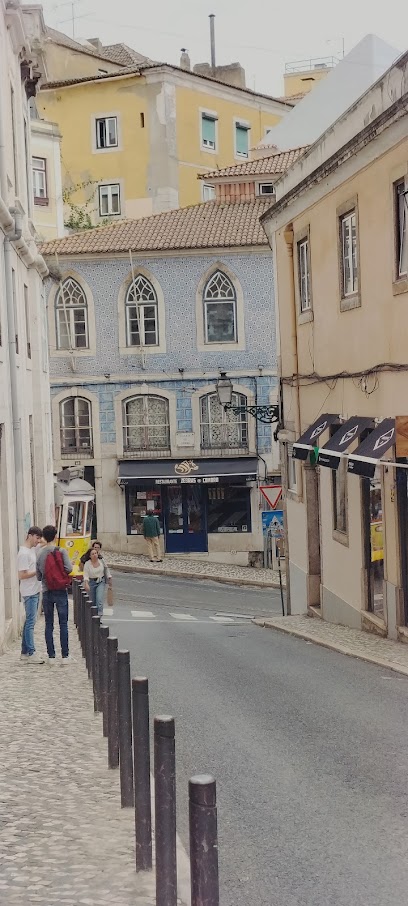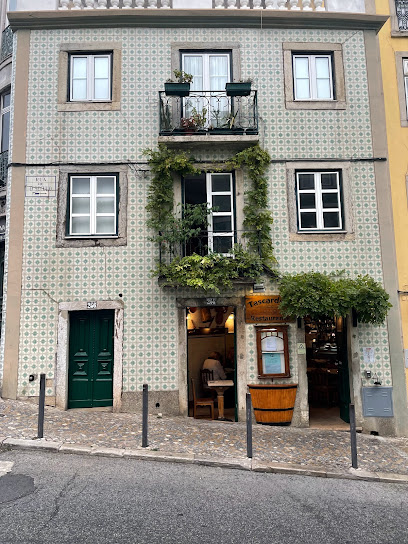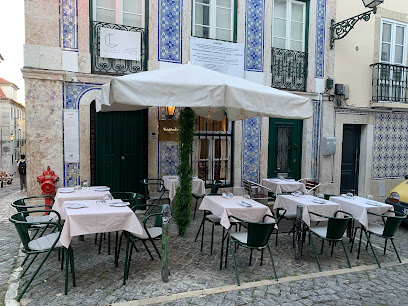
The Vibrant Heart of Lisbon: Bairro Alto
Discover Bairro Alto: Lisbon's historic neighborhood known for its charming streets, panoramic views, vibrant nightlife, and rich cultural heritage.
Bairro Alto, one of Lisbon's most iconic neighborhoods, is a must-visit for any traveler seeking to dive deep into the city's rich culture and lively atmosphere. Perched on one of Lisbon's many hills, this historic district offers a unique blend of the old and new, with its cobblestone streets, traditional Fado houses, and edgy street art. By day, Bairro Alto is a peaceful haven where you can stroll past colorful buildings adorned with azulejos (ceramic tiles) and discover quaint shops selling local crafts. The area is also home to numerous viewpoints, such as Miradouro de São Pedro de Alcântara, where you can take in breathtaking panoramas of the city and the Tagus River. As the sun sets, Bairro Alto undergoes a transformation into one of Lisbon's most vibrant nightlife districts. The streets come alive with music, laughter, and the irresistible aromas of Portuguese cuisine wafting from countless bars and restaurants. Whether you're keen to enjoy a traditional Fado performance, sip on a ginjinha (cherry liqueur), or dance the night away, Bairro Alto has something for everyone.
Local tips in Bairro Alto
- Wear comfortable shoes; the cobblestone streets can be uneven and hilly.
- Visit during the evening to experience the lively nightlife, but also explore during the day to appreciate the historic architecture.
- Try the local cherry liqueur, ginjinha, at one of the many bars.
- Check out Miradouro de São Pedro de Alcântara for stunning views of Lisbon.
- Be mindful of pickpockets, especially in crowded areas during the night.
The Vibrant Heart of Lisbon: Bairro Alto
Bairro Alto, one of Lisbon's most iconic neighborhoods, is a must-visit for any traveler seeking to dive deep into the city's rich culture and lively atmosphere. Perched on one of Lisbon's many hills, this historic district offers a unique blend of the old and new, with its cobblestone streets, traditional Fado houses, and edgy street art. By day, Bairro Alto is a peaceful haven where you can stroll past colorful buildings adorned with azulejos (ceramic tiles) and discover quaint shops selling local crafts. The area is also home to numerous viewpoints, such as Miradouro de São Pedro de Alcântara, where you can take in breathtaking panoramas of the city and the Tagus River. As the sun sets, Bairro Alto undergoes a transformation into one of Lisbon's most vibrant nightlife districts. The streets come alive with music, laughter, and the irresistible aromas of Portuguese cuisine wafting from countless bars and restaurants. Whether you're keen to enjoy a traditional Fado performance, sip on a ginjinha (cherry liqueur), or dance the night away, Bairro Alto has something for everyone.
Iconic landmarks you can’t miss
Praça Luís de Camões
Explore Praça Luís de Camões, a historic square in Lisbon filled with culture, charming cafés, and the legacy of Portugal's greatest poet.

Carmo Convent
Discover the haunting beauty and historical significance of Carmo Convent, Lisbon's remarkable archaeological museum and cultural landmark.

Game Over
Discover the excitement of Game Over Escape Room in Lisbon, where thrilling adventures and challenging puzzles await every visitor.

Jardim do Alto de Santa Catarina / Adamastor
Discover the enchanting Jardim do Alto de Santa Catarina, a tranquil garden offering stunning river views and a cultural oasis in the heart of Lisbon.

Largo Trindade Coelho
Discover the enchanting Largo Trindade Coelho, a historical landmark in Lisbon that offers a serene escape and a glimpse into the city's rich cultural heritage.

Chafariz da Rua de O Século
Discover Chafariz da Rua de O Século, a historical fountain in Lisbon that reflects the city's rich culture and architectural beauty.

Cat in sombrero
Discover the whimsical charm of 'Cat in Sombrero' in Lisbon, a delightful tourist attraction perfect for quirky photos and a taste of local creativity.

Palácio dos Marqueses de Minas - Santa Casa da Misericórdia
Discover the grandeur of the Palácio dos Marqueses de Minas, a historical landmark in Lisbon showcasing Portugal's aristocratic heritage and stunning architecture.

tourist shop
Explore Lisbon's vibrant tourist shop for unique souvenirs, local handicrafts, and a taste of authentic Portuguese culture.

lissabon
Discover the enchanting beauty of Lissabon, where rich history meets vibrant culture in Portugal's captivating capital.

Unmissable attractions to see
Castelo de S. Jorge
Explore the historic Castelo de S. Jorge, a captivating castle in Lisbon offering stunning views and rich stories of Portugal's past.

Miradouro de Santa Luzia
Experience breathtaking views at Miradouro de Santa Luzia, a charming observation deck in Lisbon showcasing the city's beauty and culture.

Praça Luís de Camões
Explore Praça Luís de Camões, a vibrant square in Lisbon celebrated for its rich history, stunning stone carvings, and lively atmosphere that captures the essence of Portuguese culture.

Carmo Convent
Explore Carmo Convent in Lisbon, a stunning historical landmark blending art and archaeology in a breathtaking setting.

Game Over
Experience the thrill of immersive escape rooms at Game Over in Lisbon, where teamwork and mystery await every adventurer.

Chafariz da Rua de O Século
Experience the tranquility and beauty of Chafariz da Rua de O Século, a historic fountain nestled in the heart of Lisbon, perfect for relaxation and photography.

Cat in sombrero
Explore the quirky charm of the Cat in Sombrero, a whimsical Lisbon attraction perfect for fun photos and capturing the city's creative spirit.

Auto do Longo
Explore Auto do Longo in Lisbon - a charming tourist attraction offering a unique blend of culture, history, and local flavors in the heart of the city.

Crafts & Design Local Market
Explore the Crafts & Design Local Market in Lisbon for unique handmade treasures, vibrant creativity, and authentic Portuguese craftsmanship.

lissabon
Explore Lisbon's rich heritage, stunning architecture, and vibrant culture in Portugal's captivating capital city.

Essential places to dine
Taberna do Bairro alto
Savor the flavors of Portugal at Taberna do Bairro Alto - where tradition meets taste in Lisbon's vibrant neighborhood.

A Nossa Casa
Discover A Nossa Casa in Lisbon: where cozy ambiance meets authentic Portuguese cuisine for an unforgettable dining experience.

Versículo d'O Faia
Experience authentic Portuguese cuisine at Versículo d'O Faia in Lisbon - where tradition meets flavor in every dish.

Lisboa à Noite
Discover traditional Portuguese cuisine at Lisboa à Noite – where flavor meets culture in the heart of Lisbon.

As Salgadeiras
Discover authentic Portuguese cuisine at As Salgadeiras in Lisbon - a must-visit destination for food lovers seeking rich flavors and vibrant atmosphere.

Flor da Laranja
Discover the authentic flavors of Morocco at Flor da Laranja in Lisbon – a must-visit destination for food lovers.

Alto do Bairro
Experience authentic Portuguese tapas at Alto do Bairro – where tradition meets flavor in the heart of Lisbon.

A Baiuca do Bairro Alto
Discover the heart of Portuguese cuisine at A Baiuca do Bairro Alto in Lisbon's lively Bairro Alto district.

Consensual
Discover the flavors of Portugal at Consensual - an exquisite bistro offering delightful tapas and a cozy atmosphere.

Bar do Chico Bairro Alto
Discover the essence of Lisbon nightlife at Bar do Chico - where traditional Fado meets delightful cocktails in Bairro Alto.

Markets, malls and hidden boutiques
Amazingstore (Príncipe Real)
Explore Amazingstore in Príncipe Real, where magic meets boutique charm, offering unique treasures and enchanting experiences in the heart of Lisbon.

Souvenirs Shop Of Lisbon
Explore the vibrant Souvenirs Shop of Lisbon for unique gifts and local crafts that capture the essence of Portuguese culture and heritage.

Vícius
Discover the eclectic charm of Vícius, Lisbon's boutique for vintage fashion and unique adult entertainment treasures.

Reliquias Da Memoria
Explore the enchanting selection of antiques at Reliquias Da Memoria, a treasure trove in the heart of Lisbon, where history comes alive through unique artifacts.

Souvenir do Portuguese
Discover authentic Portuguese souvenirs at Souvenir do Portuguese, the perfect spot for unique gifts and cultural treasures in Lisbon.

Glorious Tourist Shop
Explore the Glorious Tourist Shop in Lisbon for unique gifts and authentic souvenirs that celebrate Portuguese culture and craftsmanship.

Companhia Alfacinha
Explore Companhia Alfacinha, your go-to souvenir store in Lisbon for unique, handcrafted treasures and local cultural memorabilia.

BAIRRO ALTO SOUVENIR SHOP
Discover unique local crafts and memorable souvenirs in the heart of Lisbon's lively Bairro Alto district.

Minimercado Souvenirs Shop
Explore Minimercado Souvenirs Shop in Lisbon for unique gifts and authentic Portuguese treasures that celebrate local craftsmanship and culture.

BD Gift Shop
Explore BD Gift Shop in Lisbon for unique souvenirs that capture the spirit of Portugal and support local artisans.

Essential bars & hidden hideouts
Jam Club
Discover Jam Club, the ultimate blend of live music and exquisite tapas in the heart of Lisbon, where every evening is a celebration of flavor and rhythm.

Friends Bairro Alto
Discover the vibrant nightlife of Lisbon at Friends Bairro Alto, a lively gay bar known for its welcoming atmosphere and creative cocktails.

Tasca Mastai
Discover Tasca Mastai, Lisbon's vibrant bar offering delightful tapas and an extensive wine selection, perfect for unwinding after exploring the city.

Majong
Discover the vibrant atmosphere and unique cocktails at Majong, a top bar destination in the heart of Lisbon, perfect for a memorable night out.

Groove Bar
Experience Lisbon's nightlife at Groove Bar, where exquisite cocktails and lively beats create unforgettable nights in the heart of the city.

Maria Caxuxa
Experience the vibrant nightlife of Lisbon at Maria Caxuxa, where eclectic drinks and lively ambiance await in a cultural hotspot.

Spot Bairro Alto
Experience the vibrant nightlife of Lisbon at Spot Bairro Alto, where expertly crafted cocktails meet a lively atmosphere in the heart of Bairro Alto.

Kitsch'n live old times Bairro Alto 2009/2019
Experience the vibrant nightlife of Lisbon at Kitsch'n Live, a charming bar in Bairro Alto known for its eclectic live music and laid-back atmosphere.

Catmandoo Bar (Bairro Alto)
Discover the lively nightlife of Bairro Alto at Catmandoo Bar, a vibrant spot for cocktails and local charm in Lisbon.

Clandestino Bar
Discover the vibrant nightlife of Lisbon at Clandestino Bar, where eclectic cocktails and a lively atmosphere await every visitor.

Local Phrases
-
- HelloOlá
[oh-lah] - GoodbyeAdeus
[ah-deh-oos] - YesSim
[seem] - NoNão
[now] - Please/You're welcomePor favor
[por fah-vohr] - Thank youObrigado
[oh-bree-gah-doo] - Excuse me/SorryDesculpe
[deh-skool-peh] - How are you?Como está?
[koh-moh ehs-tah] - Fine. And you?Bem. E tu?
[behn. eh too] - Do you speak English?Fala inglês?
[fah-lah een-glehsh] - I don't understandNão entendo
[now ehn-tehn-doo]
- HelloOlá
-
- I'd like to see the menu, pleaseGostaria de ver a ementa, por favor
[gohs-tah-ree-ah deh vehr ah eh-men-tah. por fah-vohr] - I don't eat meatNão como carne
[now koh-moh kahr-neh] - Cheers!Saúde!
[sah-oo-deh] - I would like to pay, pleaseGostaria de pagar, por favor
[gohs-tah-ree-ah deh pah-gahr. por fah-vohr]
- I'd like to see the menu, pleaseGostaria de ver a ementa, por favor
-
- Help!Ajuda!
[ah-zhoo-dah] - Go away!Vá embora!
[vah ehm-boh-rah] - Call the Police!Chame a polícia!
[shah-meh ah poh-lee-see-ah] - Call a doctor!Chame um médico!
[shah-meh oom meh-dee-koo] - I'm lostEstou perdido
[ehs-toh pehr-dee-doo] - I'm illEstou doente
[ehs-toh doh-ehn-teh]
- Help!Ajuda!
-
- I'd like to buy...Gostaria de comprar...
[gohs-tah-ree-ah deh kohm-prahr] - I'm just lookingEstou só a ver
[ehs-toh soh ah vehr] - How much is it?Quanto custa?
[kwan-toh koos-tah] - That's too expensiveIsso é muito caro
[ee-soh eh moo-ee-toh kah-roo] - Can you lower the price?Pode baixar o preço?
[poh-deh bahy-shahr oh preh-soh]
- I'd like to buy...Gostaria de comprar...
-
- What time is it?Que horas são?
[keh oh-rahss sah-oh] - It's one o'clockÉ uma hora
[eh oo-mah oh-rah] - Half past (10)Meia hora
[may-ah oh-rah] - MorningManhã
[mahn-yah] - AfternoonTarde
[tahr-deh] - EveningNoite
[noy-teh] - YesterdayOntem
[ohn-tehm] - TodayHoje
[oh-zheh] - TomorrowAmanhã
[ah-mahn-yah] - 1Um
[oom] - 2Dois
[doh-ees] - 3Três
[trehs] - 4Quatro
[kwah-troh] - 5Cinco
[seen-koh] - 6Seis
[saysh] - 7Sete
[seh-teh] - 8Oito
[oy-toh] - 9Nove
[noh-veh] - 10Dez
[dehsh]
- What time is it?Que horas são?
-
- Where's a/the...?Onde está o/a...?
[ohn-deh ehs-tah oh/ah] - What's the address?Qual é o endereço?
[kwahl eh oh ehn-deh-reh-soh] - Can you show me (on the map)?Pode mostrar-me (no mapa)?
[poh-deh moh-strahr-meh (noo mah-pah)] - When's the next (bus)?Quando é o próximo (autocarro)?
[kwan-doo eh oh proh-ksih-moh (ow-toh-kah-roo)] - A ticket (to ....)Um bilhete (para ....)
[oom bee-lyeh-teh (pah-rah)]
- Where's a/the...?Onde está o/a...?
History of Bairro Alto
-
Bairro Alto was established in the late 16th century, originally designed as a residential area for the upper class of Lisbon. The neighborhood's name translates to 'High Neighborhood', reflecting its elevated position above the city. Its layout was influenced by the Pombaline architectural style after the 1755 earthquake, which reshaped much of Lisbon.
-
Throughout the 19th century, Bairro Alto became a center for artists, intellectuals, and bohemians. The neighborhood was characterized by its vibrant nightlife and cultural scene, fostering movements in literature and the arts, including Fado music, which emerged as a poignant expression of Portuguese identity and sorrow.
-
During the Salazar dictatorship (1932-1968), Bairro Alto became a meeting point for political dissidents and revolutionaries. The neighborhood's bars and taverns provided a space for clandestine discussions and planning against the authoritarian regime, playing a significant role in the eventual Carnation Revolution of 1974, which led to the fall of the dictatorship.
-
In the late 20th and early 21st centuries, Bairro Alto experienced significant gentrification. As Lisbon became a popular tourist destination, the neighborhood underwent modernization, with many historic buildings being restored. This transformation has sparked both admiration for its vibrant atmosphere and criticism regarding the loss of its traditional character and affordability for local residents.
-
Today, Bairro Alto is known for its lively street life, bars, and restaurants, hosting various cultural events and festivals throughout the year. The neighborhood's annual 'Festa de São João' and 'Festivals of Fado' highlight its rich cultural heritage and continue to attract both locals and tourists, preserving its identity while adapting to contemporary trends.
Bairro Alto Essentials
-
Bairro Alto is conveniently located in the heart of Lisbon and can be easily accessed from other neighbourhoods. The closest metro station is Baixa-Chiado (Blue and Green Lines), which is just a short walk away. Tram 28 also passes through, offering a scenic route. From Alfama, you can take Tram 12 or a 15-minute walk. If you're coming from the airport, take the AeroBus to Cais do Sodré and then walk or take a taxi.
-
Bairro Alto is a walkable neighbourhood, ideal for exploring its narrow streets and vibrant atmosphere. Public transport options include the funicular (Elevador da Bica) and tram services. Taxis and rideshare apps like Uber are widely available. For a more local experience, consider renting a bicycle or using electric scooters, which can be found throughout the city.
-
Bairro Alto is generally safe for tourists, but exercise caution, especially at night when the area can become lively. Be wary of pickpockets in crowded places, particularly around popular bars and clubs. Areas around Praça Luís de Camões and Rua da Atalaia can experience higher crime rates, so stay vigilant and keep your belongings secure.
-
In case of an emergency, dial 112 for police, fire, or medical assistance. The nearest hospital is Hospital de São José. It's advisable to have travel insurance that covers health emergencies. For non-urgent medical needs, pharmacies are available, often with English-speaking staff.
-
Fashion: Do wear comfortable shoes for walking; Bairro Alto's streets can be steep. Don’t wear overly flashy jewelry that may attract unwanted attention. Religion: Do be respectful when visiting local churches and religious sites. Public Transport: Do validate your ticket before boarding and don’t disrupt others during their commute. Greetings: Do greet locals with a friendly 'Olá' and a smile. Eating & Drinking: Do try local wines and petiscos (Portuguese tapas), but don’t engage in excessive loudness or rowdiness in dining establishments.
-
To experience Bairro Alto like a local, visit the local markets for fresh produce and artisanal goods. Try to learn a few basic Portuguese phrases; locals appreciate the effort. Explore the area during the day for its shops and galleries, and return at night to enjoy the vibrant bar scene. Consider visiting a Fado restaurant for an authentic cultural experience, and don’t miss the sunset views from Miradouro de São Pedro de Alcântara.
Nearby Cities to Bairro Alto
-
Things To Do in Sintra
-
Things To Do in Cascais
-
Things To Do in Setúbal
-
Things To Do in Caldas da Rainha
-
Things To Do in Évora
-
Things To Do in Viseu
-
Things To Do in Tomar
-
Things To Do in Coimbra
-
Things To Do in Badajoz
-
Things To Do in Faro
-
Things To Do in Aveiro
-
Things To Do in Huelva
-
Things To Do in Porto
-
Things To Do in Lamego
-
Things To Do in Vila Real













